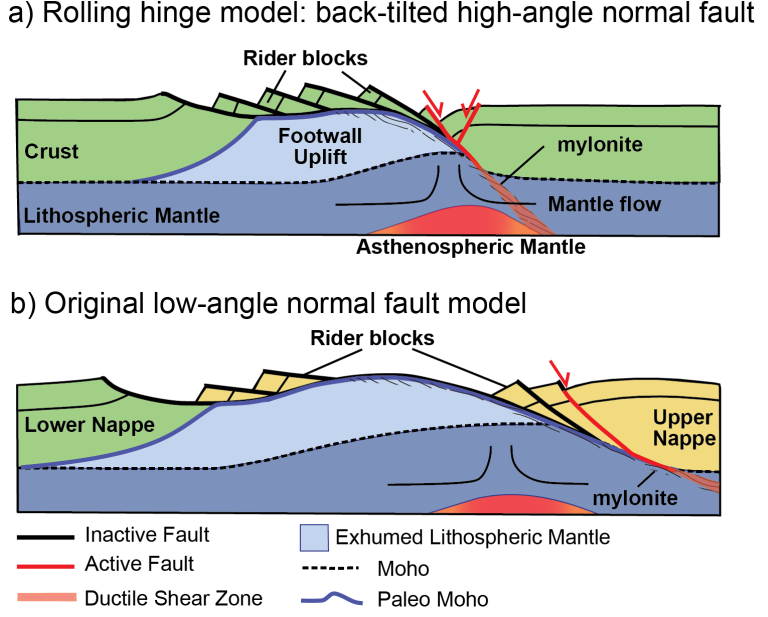
In 1999 Jean-Pierre Brun published his Must-Read paper about rifting, in which he reviews fifteen years of laboratory experiments at Geosciences Rennes. In a brief introduction the paper reminds the reader of the two main rift types: narrow rifting as the preceding stage for continental break-up, and wide rifting that occurs after cessation of convergence. The article introduces some key differences between the two types of rifts, and then briefly reviews the underlying mechanics and scaling principles for the analogue modeling. The paper discusses experiments with sand (brittle) and silicone (ductile) layers, exposed to variable strain rates, layer thicknesses, layer set-ups, extension modes and layer heterogeneities, before summing up the main conclusions.
An important difference between wide and narrow rifting is brought forward here: they are the direct effect of the type of instability that can develop: necking (narrow rift) or spreading (wide rift). Necking typically occurs in 4-layer models with the upper mantle as the strongest layer, and tends to be more localized for thick brittle layers, especially with low strain rates. Spreading typically occurs in a thickened lithosphere where the upper crust is the strongest layer, and the crust-mantle boundary remains nearly horizontal. Core complexes – zones of ductile lower crust brought to the surface during extension – are found to be the result of anomalies within the wide rift type category.

Figure 1: Schematic examples of a narrow rift and a wide rift. In the analogue models of Brun (1999), sand represents brittle layers, and silicone represents ductile layers. Modified from Beniest (2017).
Interestingly, the paper contains a discussion section at its end, with a short Q&A between several known tectonicists of that time (R. Buck, D. McKenzie, N. Kusznir among others) and Jean-Pierre Brun. Some comments seem outdated now -like the question whether computer models of extension will eventually be able to account for heterogeneities- but others seem still up-to-date, like the considerations of experimental limitations for instance. Specifically temperature effects, which force the material to change from ductile to brittle behavior and vice versa in nature, cannot be easily simulated. Along the same lines, localizing deformation in the ductile layers for large and rapid strain is impossible with the silicone, although in nature this could occur in the lower crust during earthquakes.
These well-known limitations do not take away the first order findings put forward in the paper. As the paper neatly summarizes fifteen years of experiments, it would make for an ideal starting point to analogue modelers, especially those studying extensional systems. The experiments also provided a step forward in the debate on core complex origins. End-member models for core complexes include ‘simple shear models’ (e.g. Wernicke and Burchfiel, 1982), in which a large low-angle fault across the lithosphere exhuming the lower crust, and ‘rolling hinge models’ (e.g. Buck, 1988), in which initially steep faults eventually rotate to lower angle faults during ongoing rotation. The experimental results presented in this work have been among the most important arguments for the rolling hinge type models, which are currently favored in most studies.

Figure 2: Examples of core complex end-members. The analogue experiments in Brun (1999) support the ‘rolling hinge’ model. From Webber (2017)
In the Reddit discussion – feel free to add your thoughts – Akinbobola Akintomide pointed out that the paper is interesting and provides some important insights on the way in which narrow and wide rifts form. He also notes that the spatial heterogeneities that are so common in nature are typically not well represented in laboratory analyses. Gianluca Frasca recommends a more recent article on the same topic for those who want to learn more (Brun et al., 2018), as well as the Arthur Holmes Medal lecture given by Jean-Pierre Brun at EGU 2017 (link).
Gino de Gelder, Akinbobola Akintomide, Gianluca Frasca and the TS Must Read team
References
Anouk Beniest. From continental rifting to conjugate margins : insights from analogue and numerical modelling. PhD Thesis, Earth Sciences. Université Pierre et Marie Curie – Paris VI, 2017. https://tel.archives-ouvertes.fr/tel-01706702
Brun, J.-P. (1999). Narrow rifts versus wide rifts: inferences for the mechanics of rifting from laboratory experiments. Philosophical Transactions. Series A, Mathematical, Physical, and Engineering Sciences, 357(1753), 695–712. https://doi.org/10.1098/rsta.1999.0349
Brun, J.-P., Sokoutis, D., Tirel, C., Gueydan, F., Van Den Driessche, J., & Beslier, M.-O. (2018). Crustal versus mantle core complexes. Tectonophysics, 746, 22–45. https://doi.org/10.1016/j.tecto.2017.09.017
Buck, W. R. (1988). Flexural rotation of normal faults. Tectonics, 7(5), 959–973. https://doi.org/10.1029/TC007i005p00959
Webber, S. (2017). Using structural geology and cosmogenic nuclide dating to infer the slip rate and frictional strength of the active Mai’iu low-angle normal fault, Eastern Papua New Guinea. PhD Thesis, Victoria University of Wellington. http://researcharchive.vuw.ac.nz/handle/10063/6183
Wernicke, B., & Burchfiel, B. C. (1982). Modes of extensional tectonics. Journal of Structural Geology, 4(2), 105–115. https://doi.org/10.1016/0191-8141(82)90021-9


Xin Xianwu
Hello editor Hannah Davies! Can you give me another mailbox for submissions? The mailbox on the interface cannot be opened.
Hannah Davies
Do you mean the mailbox on the main page with my name? If you would like my email, please search my name (Hannah Sophia Davies) online, I would prefer not to put my email here in plain text